Just What I’m Going Through / They Can’t Understand*
November 23, 2007 at 12:45 pm · Filed under Identity / Systems, Uniforms / Apparel
Here I am racing in “The Whites” at the Volunteer Park Criterium; Seattle / 1999 (photographer unknown)
In a lot of ways, 1999 was an awful year for our young Mr. Daniel P. Johnston. I had a steady job that I hated, basically because I had no idea what I was doing (this job will remain unnamed – it’s not on my résumé). My long-term girlfriend had left for another city. I had parted ways with the cycling team with which I had last raced, primarily because I felt that both my racing and managerial contributions had been under-appreciated. After quite a bit of initial work, I had lost a job to create the identity for a very prominent new bike company (to the client’s girlfriend – while I was on vacation). And, most unfathomably, I had dropped out of college after not being accepted to the Visual Communication Design major. I also got hit by a car (again).
About the only aspect of my life that hadn’t come crashing down on me (or into me) was my passion for bike racing. At this point, I was a precocious wheelman, racing in the top echelons of the northwest’s pro/am ranks, and I was getting faster by the minute – without hardly trying. The idea of going professional at some point even seemed possible to me. But I didn’t think any of the local teams could help me in this pursuit. Indeed, after taking such a hail of blows from so many different directions in such a short span of time, I felt like there was only one entity on which I could truly rely, and that was myself. So I set about creating my own team for the ’99 season, comprising just one member: me…
I not only wanted to race for myself, I wanted everyone to know that I was racing for myself. I wanted to make a statement. In addition to feeling hung out to dry by the world in general, I had the specific belief that almost everyone on local bike racing teams were deluding themselves in thinking that their team membership actually meant something. Moreover, I had surmised that these teams only made their members act and ride just like each other (ironically, a useless if not counterproductive goal for a team), and that they goaded a blindly inimical derision of other teams’ members. (The idea that I shouldn’t like someone because they were on a different bike team always seemed idiotic to me.)
And what do teams offer in return? A good deal on a bike or other gear? I worked at a bike shop (part-time, in addition to the other job), so I had that covered already. Team rides? I had enough friends on different teams that I could pick and choose any ride I wanted to join. Race-winning tactical synergy? That was the biggest delusion of them all, because hardly anyone actually wanted to race in a way that would benefit their team (even if they knew how, and most didn’t), because everyone always thought that they were the ones who could win (in fact, there was only a tiny percentage of racers who could win any race). Race entry fees? Sure, if you’re high enough on the ladder, teams will often cover your races, but I felt that fronting these costs myself was a song to pay for freedom.
I designed my statement with wit and restraint. Many people think that good design entails the application of some sort of pictographic style to make something look better. I could not disagree with this definition more. Design is about communicating a message. There is absolutely no requirement that it be fancy, pretty, difficult to produce, or anything else, as long as it delivers its message in a compelling way. As proof, I think my racing kit for 1999 was one of the most powerful works of design I have ever created, and it required nothing more of me than a phone call to a custom clothier.
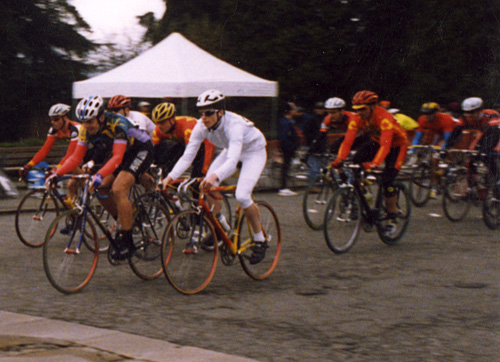
Here’s another shot of me at the Volunteer Park Criterium. Just behind me and to my right are two of my former teammates. (photograph by Bob Stroschein)
The way I made my anti-team statement was a simple exaggeration of an old regulation of the USCF (now USA Cycling), the governing body of U.S. competitive cycling, which stated that anyone not on an officially sanctioned team was to wear a white jersey. I just decided to take this to the nth degree and get ALL of my clothing in white: I had white jerseys (short and long sleeve), white arm-warmers, white shorts, white knee-warmers, white knickers, white socks, white glasses, and a white helmet. Now anyone can buy white cycling shorts off the shelf, but in 1999, this was virtually unheard of (the guy who made my clothes certainly hadn’t heard of it). I would have bought white shoes, too, but they weren’t available then. The whole kit was the antithesis of standard bike team wear, which is often a cacophony of meaningless “graphics,” littered with hoards of nickel-and-dime sponsor logos.
My bike was a slightly different story. Shortly into the season, I had purchased one of the last four Bontrager Road-Lite frames left in the factory, just before the pioneering builder sold out to Trek. This frame, the only road model designed by Keith Bontrager – who is credited as one of the inventors of the mountain bike – was an eccentric piece, years ahead of its time (although that time had come and gone by the year that I got mine). Since I got such a deal on the closeout, I decided I would treat myself to a custom paint job by one of the best painters in the country (read: not such a deal).
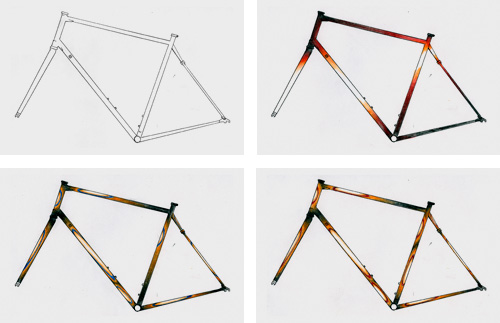
Much like the TT bike I designed, I made several scale drawings of my new frameset before deciding on a final paint-scheme. / 1999
If I truly wanted to make my statement complete, I would have had the frame painted white (top left), which I did consider. But I was young, and I just couldn’t resist going all-out: four colors, including fades, candy-apple swooshes, and custom, exponentially-kerned type, as well as my monogram on the head tube and seat tube (much to my chagrin, one of the two monograms was put on upside-down by the painter). I did cover the thing in my own name, which helped with my statement (too bad I set everything in a typeface that I now hate). But the coup de grâce of my one-off bike was certainly the top tube badging: “Team Issue.”
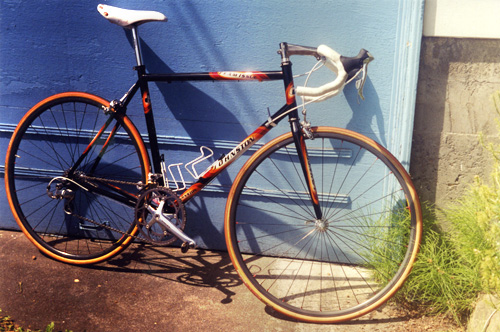
Here is my “Team Issue” bike all built up, with Shimano Dura Ace components, paint-scheme-matching tires on a custom wheelset that I built, a Cinelli Ti Grammo stem, extra-pro white bar tape, and a rare white Selle San Marco Regal saddle, given to me by a friend of mine at the bike shop where I worked. This bike was nice to look at and it rode well, but it was also at least two pounds heavier than almost everyone else’s bikes.
My team did relatively well that year. I was very competitive, and I had a few solid results here and there – more than I had had on any real, sanctioned team. Thanks to my good friend Ingy, I was able to go to Chicago / Wisconsin to race Super Week, a mythic series of incredibly fast races with rich prize lists and deep, pro-dominated fields – and I even did okay there. More importantly, I didn’t have to endure any in-fighting team bullshit, I didn’t have to pretend that I was on some sophisticated training program, I didn’t have to participate in any inane post-race debriefings, I didn’t have to go to team meetings, and I could be friends with whomever I chose, no matter which team they were or were not on.
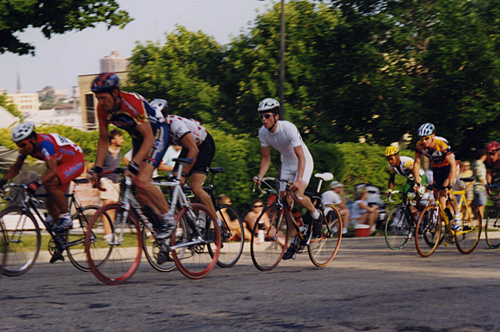
Here I am racing at Super Week, just behind Harm Jannsen, a Euro-pro transplant to the USPRO scene; somewhere in Wisconsin / 1999 (photo by Jen Paur)
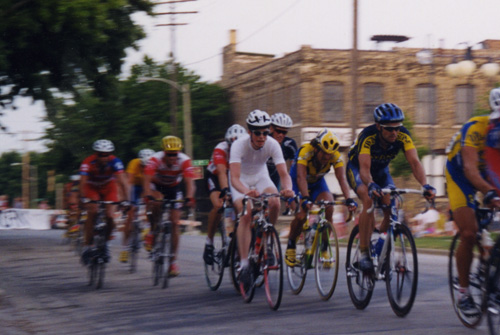
Here’s another shot from the same race. The guy just behind me to my left in the yellow helmet is Roberto Gaggioli, one of the most successful riders in USPRO history. The guy immediately to my left is Marcel Wüst, a multiple Tour de France stage winner. / 1999 (photo by Jen Paur)
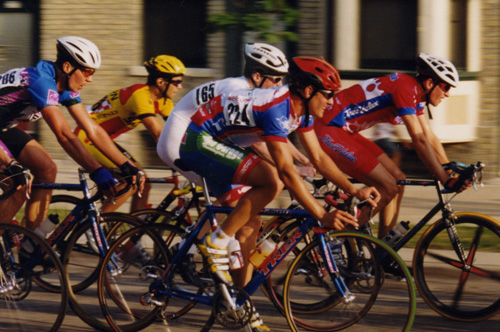
Here’s another shot of me at Super Week. The guy behind me to my left is Robbie Ventura, one of the best sprinters in the U.S. at the time. / 1999 (photo by Jen Paur)
I would go on to join other teams later in my racing days, but I’m not really sure why. Maybe I’m just a sucker for acceptance or prestige-by-association; a couple of those teams were quite well-respected. But, to this day, I think I had it right in ’99 (if only in terms of bike racing). I may never race in “The Whites” again – whether I am on a team or not – but I look back with satisfaction on the season when, in every possible fashion, I did it my way.**
* From “Knights in White Satin” written and performed by The Moody Blues / 1967
** From “My Way,” lyrics written by Paul Anka and Frank Sinatra, performed by Frank Sinatra / 1968 (and later by Sid Vicious, among many others)

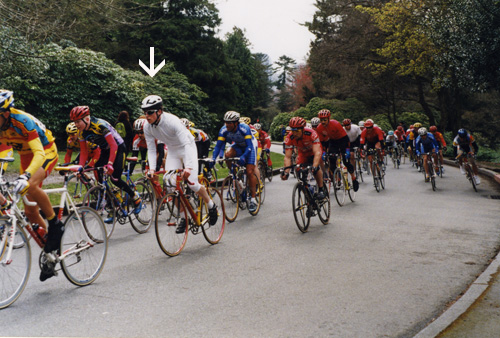
jen said,
December 5, 2007 at 12:37 am
Those were good days.
I was surprised to see my credits for the photos. I took photos in Wisconsin? Don’t remember. I did, however and apparently, do a pretty kickass job at getting you with pictures of all those famous guys. Way to go me.